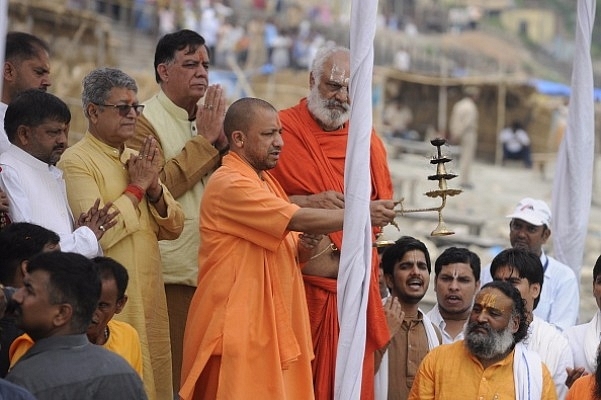Blogs
Open Letter To Yogi Adityanath: Build Ram Statue In Ayodhya With Donations
- A state-sponsored statue cannot achieve the sense of ownership that people will feel if they helped contribute to it themselves.

Uttar Pradesh Chief Minister Yogi Adityanath doing arti at Sarayu River ghat in Ayodhya. (Deepak Gupta/Hindustan Times via Getty Images)
Dear Yogi Adityanath,
Your government’s intention to build a Ram statue in Ayodhya on the banks of Sarayu River has become a subject of debate, perhaps a little too early. But such are the times. It is being argued that you can do better than waste public money to build statues only to fulfill a religious agenda while greater challenges lie before you.
How public money is used by states is very much a subject that citizens should feel deeply for and ask questions on. While there can hardly be consensus each time, and neither side is right or wrong, scrutiny is important.
While this is essentially a plan to boost tourism in the holy town, questions are being asked if you and, by extension, ‘we’ really need a towering Ram statue to remind us of who we are, even as law and order and especially hospitals, including in your constituency of Gorakhpur, continue to reel.
Now I am sure you will have your ‘facts’ to present in such cases. Like your police’s crackdown on the mafia and the work done to curb encephalitis over the years in Gorakhpur. But if it wasn’t this, it would be something else.
You are not popular with the popular media. Every action of yours will be carefully examined and dissected, especially one pertaining to religion and Ram. Intentions don’t matter here – whether or not the statue is but a gimmick to keep ‘Hindutva’ high up in the minds of the people.
I do have a solution for this dilemma though. Fund this proposed statue of Lord Ram using public donations. Start a campaign. Reach out to people. Create a fund. Bypass the entire narrative around misuse of public funds.
Can you imagine the shock and awe of your detractors if you did this? It will become nearly impossible for them to criticise the building of the statue.
This should not be too hard to do. Only 40 per cent of the country's people need donate just Rs 5 each to achieve a target of Rs 200 crore, the reported expected cost. Or just Rs 200 each by 10 per cent of the population, and so on. You get the point.
Give people a structure they can feel a part of instead of a state-dole project. Save this statue (if it comes through) from a fate of continuous political bickering. Keep it from becoming another in the list of misplaced priorities of state governments, or a desperate attempt by a new chief minister to try and leave his mark. Let it not be a reminder of calculations of what else – morally better – could have been done with all this money.
The entire journey can be one of great inspiration for generations to come – from the conception of the idea to the making of the statue.
This campaign will not only have the power to bring people together, extend a feeling of communal participation and celebration of religion itself, but also become its own marketing and advertising.
Anyone who donates even a paisa to build this statue will come at least once in their lifetime to visit it. Others will come to see what people coming together for a cause can achieve.
I would go to the extent to say that the only thing better than building this statue with donations is actually restoring the already existing temples and monuments of great cultural and historical heritage with donations. We already have a lot to be proud of, even in Ayodhya. And before we set out to make more, we must restore past glory to actually send out a message of preservation.
Nevertheless, this can be good start and a model to emulate in the future. Donations of such a kind have been commonplace in temples across India. Prominent citizens donate money to fund parts of the construction. Benches, walls and stairs in temples have names of those who helped install them.
However, this initiative will not be limited to those who have the money to make a substantial contribution but an entire mass of people.
Erect a wall with the names of all those who fund this statue. Make this an example. Ask for donations through digital payments, thus promoting the centre’s push for the same. People from remote parts of India and far-off locations overseas can easily send money digitally.
A state-sponsored statue cannot achieve the sense of ownership that people will feel if they helped contribute to it themselves. Chances are, people will also take better care of it for generations if it were built this way.
This need not be a tussle. It can instead be an enormous opportunity.
Introducing ElectionsHQ + 50 Ground Reports Project
The 2024 elections might seem easy to guess, but there are some important questions that shouldn't be missed.
Do freebies still sway voters? Do people prioritise infrastructure when voting? How will Punjab vote?
The answers to these questions provide great insights into where we, as a country, are headed in the years to come.
Swarajya is starting a project with an aim to do 50 solid ground stories and a smart commentary service on WhatsApp, a one-of-a-kind. We'd love your support during this election season.
Click below to contribute.
Latest